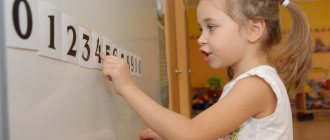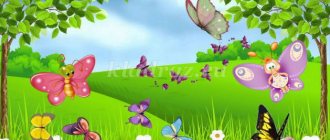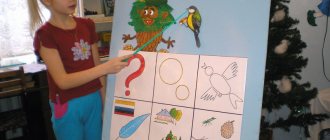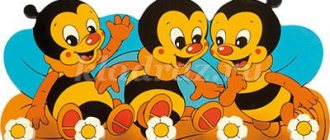Summary of a lesson on FEMP in the middle group using multimedia support
“Journey to the land of geometric shapes” Lesson on FEMP in the middle group using multimedia accompaniment.
Author: Likhovskikh Ruzigul Gardulloevna teacher of the KGKOU orphanage 18 p. Otradnoye, Vyazemsky district, Khabarovsk Territory. Description: When working with children, the use of multimedia technologies (color, graphics, sound, modern video equipment) allows me to simulate various situations, activate the cognitive activity of students and enhance the assimilation of material. The use of information technology in a preschool educational institution is possible and necessary; it helps to increase interest in learning and develops the child comprehensively. The clarity of the material increases its absorption, because All channels of perception of children are involved - visual, mechanical, auditory and emotional. The use of multimedia accompaniment in mathematics classes ensures the activity of children when examining, examining and visually identifying the signs and properties of objects; methods of visual perception, examination, and identifying qualitative, quantitative and spatio-temporal signs and properties in the objective world are formed. The formation of elementary mathematical concepts occurs on the basis of the construction and use of visual models by children. The use of new unusual methods of explanation and reinforcement, especially in a playful form, increases children’s involuntary attention and helps develop voluntary attention. Information technology provides a person-centered approach. Program tasks : 1. Familiarization with volumetric geometric shapes; 2. the ability to compare objects by size, distinguish between three-dimensional and flat geometric shapes; cube, cylinder, cone, etc. square, triangle, circle, etc. 3. Formation of visual perception, examination, identification of qualitative, quantitative and spatio-temporal signs and properties in the objective world. 4. Development of visual attention and visual memory. 5. Replenishment of vocabulary. 6.Cultivate an interest in mathematics and a desire to work in a team. MATERIALS FOR THE CLASS ;
Demonstration; educational video “Chuk-Chuk the train and geometric shapes” Handout; volumetric, plastic geometric shapes (you can make shapes from paper); A-4 sheets of paper, pencils. Progress of the lesson
- Guys, today we, together with the little engine Chukh-Chukh, will go on a journey to the land of geometric shapes, the journey will be interesting and exciting. And you look carefully and try to remember everything that the train will show you. - So, let's begin our journey... - Did you like the journey with the Chukh-Chukh train? - Now let's see how attentive you were during the trip. - Please note that in front of you there are geometric figures the same as those transported by the train. - Show and name the figures that the Chukh-Chuk train transported? (cube, cuboid, pyramid, cone, cylinder, ball, torus, prism) - What are all these geometric shapes called and why? (three-dimensional figures, because they have volume, i.e. they take up space in space). - Let's see what happens if we trace the base of each volumetric figure on a sheet of paper. What are the names of the figures drawn on paper? (flat figures; cube-square, cuboid-parallelepiped, pyramid-square-triangle-polygon, cone-circle, cylinder-circles, prism-triangle-polygons). — Please show me the pyramid and the cone. What is the difference? (a pyramid has a base of a square, a rectangle, a triangle, a polygon, and a cone has a base that is always a circle and has no edges). - What are their similarities? (both the pyramid and the cone have a base and an apex). - Who will show me the ball? How is he different from all the figures? (the ball has no base, corners, sides). —What types of prisms are there? (triangular, polygonal), why are they called that? (because they are based on a triangle, polygons). - Well done guys, today you were attentive and learned to distinguish three-dimensional geometric shapes. Now you can play with the figures, build houses, a palace, gates and other buildings. Fantasize yourself.
We recommend watching:
Summary of a comprehensive lesson on FEMP with elements of application in the middle group. Summary of a lesson in mathematics in the middle group of kindergarten. Synopsis of a game-based cognitive lesson on FEMP in the middle group. Synopsis of joint activities on mathematical development for children of the middle group.
Similar articles:
Math lesson “Rectangle” in the middle group of kindergarten
Mathematics lesson “Ordinal counting” in the middle group
Target. Give children an idea of some of the properties of a ball, cube, cylinder: stability and instability, the presence and absence of angles; teach to examine models of figures by tactile-motor means; exercise children in establishing dimensional relationships between 2-4 objects in terms of volume as a whole; consolidate the ability to establish relationships between 5 objects in height; find objects whose height is equal to the length of the strip; practice counting within 5; learn to install an equal number of objects of different sizes.Demonstration material: models of a ball, cube, cylinder (2 pieces each of different colors and sizes). On two utility tables standing next to each other, there are Christmas trees of different heights, gradually decreasing from 25 to 5 cm, 5 Christmas trees of each size (one per child).
Handouts: boxes containing models of a ball, cube, cylinder (3-4 models of each type per child); models are gradually decreasing in size.
Organization of the environment. Children sit at tables arranged in a “P” formation.
Progress of the lesson.
Part 1. The teacher invites the children to take the ball, roll it on the table, and then try to roll the cube. When the children perform the actions, the teacher says: “Why doesn’t the cube roll? Trace the cube with your finger! Feel it! What does a cube have? That's right, the cube has corners! Lots of angles! Does the ball have angles? Roll the ball between your palms!” Then he invites the children to take the cylinder and asks: “Can the cylinder roll? Can he stand? Which rolls better: a ball or a cylinder? Then he gives a new task: to build a turret from cylinders, and a ladder from cubes, and then characterize the size of the figures (“larger”, “smaller”) in the order of their location. It is useful to compare the number of cubes and cylinders.
Part 2. The teacher explains the task: “There are spruce trees of different heights growing in the forest. Among them there are very tall spruces, shorter ones, even lower ones and very short ones. Now you and I will go into the forest to look for Christmas trees. We’ll have to find a Christmas tree the same height as the strip.” Call children in groups of 5 in turn and give them stripes. Each subsequent subgroup of children receives strips of a smaller size (the length of the measuring strips decreases accordingly from 25 to 5 cm). All children find 1 Christmas tree. Next, the teacher calls those children who found the tallest Christmas trees and invites them to put the trees in a row one after another, and for those whose Christmas trees are a little lower, to put their Christmas trees in the second row, next to the first ones. When all the Christmas trees are arranged in rows, the teacher asks: “Is the Christmas tree the same height in each row? How tall is the Christmas tree in this (first, etc.) row?” They find out that the Christmas trees are arranged in rows in order, starting with the tallest and ending with the shortest, in each row there are Christmas trees of the same height. Next, the teacher asks: “How many rows of Christmas trees are there in total? How many Christmas trees are there in each row? Calls on several children who count the rows and Christmas trees of each row. The teacher leads the children to a generalization: “There are 5 Christmas trees in each row.”
Summary of educational activities for studying mathematics in the middle group of preschool educational institutions
Tasks:
strengthen children's ability to count to 5; form an idea of equality and inequality of 2 groups of objects based on counting; consolidate the ability to distinguish between a ball, cube, and cylinder; consolidate the ability to distinguish between the left and right hand, determine spatial directions and denote them with words: left, right, forward, backward.
Visual material
: toys (5 pcs.), doll cups (5 pcs.), 3 chairs, figures (cube, ball, cylinder).
Handout
: figures (cube, ball, cylinder) according to the number of children.
Progress of the lesson
1 part. Game situation “Guests have come to us.” The teacher informs the children that toys have come to visit them (places 5 dolls). Finds out from the children what needs to be done to find out how many guests have arrived? Children's answers: “We need to count.” The teacher counts together with the children and makes a generalizing gesture and clarifies with the children: “How many guests have come?” Children: "5". The teacher offers to treat the guests to tea and put a cup for everyone. One child places cups in front of each toy. And he counts how many cups he placed (4). The teacher clarifies: “5 dolls and 4 cups - compare, which is bigger? (5 dolls are more than 4 cups). Compare 4 cups and 5 dolls, which is smaller? (4 cups less than 5 dolls). How can we make it so that there are equal numbers of dolls and cups?” Children discuss two ways to equalize objects: by adding or subtracting one object. The called child equalizes objects in one of the following ways. “How many dolls and cups are there?” - the teacher finds out. Then he restores the inequality and asks another child to establish equality in a different way. The teacher clarifies the formation of the number 5.
Part 2. Game exercise “Find your place.” The teacher puts three chairs and places geometric shapes on them (cube, cylinder, ball). Before the game, the teacher shows the figures, asks them to name the form and show what actions can be performed with them. The teacher shows the cube: - What is the name of the figure? (Cube). - That he has? (Sides and corners). - What actions can be performed with it? (Put). The teacher shows the ball: - What is the name of the figure? (Ball). - Does it have corners and sides? (No, it's smooth). - What actions can be performed with it? (Ride). The teacher shows the cylinder: - What is the name of this figure? (Cylinder). - How are a cylinder and a ball similar? (You can ride them). — How are a cylinder and a cube similar? (They can be installed). The teacher calls three groups of children and distributes figures to them and explains: - While I am knocking on the tambourine, you walk in different directions. As soon as the tambourine stops playing, you need to find your place. The game is repeated several times.
Physical education minute
The bear cubs lived in the thicket They twisted their heads Like this, like this (circular movements with their heads) They twisted their heads The bear cubs were looking for honey Together they rocked the tree (raise their arms up and tilt to the right and left) Like this, like this They rocked the tree together, And then they walked (walking like a bear) And they drank water from the river Like this, like this And they drank water from the river (the torso bends forward) And then they danced (springs with the torso turning left and right) They raised their paws higher (jumping, clapping their hands at the top) Like this, like this, raised their paws higher!
Part 3. Game exercise “Where will you go and what will you find?” The teacher hides toys familiar to the children in different places in the group. Then the teacher asks riddles: He slept in a fur coat all winter, He sucked a brown paw, And when he woke up, he began to roar. This is a forest animal... Children: “Bear.” Educator: - Well done, you guessed the riddle. Tell me, where is the bear to your right or left? Children's answers. Educator: - Listen to the next riddle. Freckled back. Oh, how awkward! And she blushed... Children: “Ladybug.” Educator: - Well done, you guessed the riddle. Tell me, where is the ladybug on your left or right? Children's answers. Educator: - Listen to the next riddle. In his garden, Andreika was watering flowers from... Children: “Water cans.” Educator: - Well done, you guessed the riddle. Tell me, where is the watering can in front or behind you? Children's answers. Educator: - Listen to the next riddle. This animal lives only at home. Everyone is familiar with this beast. Its mustache is like knitting needles. He purrs and sings a song, Only the mouse is afraid of him. Guess it? This is... Children: "Cat." Educator: - Well done, you guessed the riddle. Tell me, where is the cat behind or in front of you? Children's answers. At the end of the lesson, the teacher sums up the lesson.
Outline of a lesson in mathematics (middle group): Outline of a lesson on FEMP. Topic: “Ball and Cube”
Objectives: 1. Introduce children to the geometric shapes of a ball and a cube. Learn to find round and square objects in a specially created environment. 2. Improve the ability to distinguish between red, green and yellow colors. 3. Foster independence. Material: geometric shapes: ball and cube, construction sets, truck. Progress: Watercolor. Hello guys! Smesharik Krosha and I decided to build a house. They brought building materials for the house in a yellow truck. — I chose cubes to build a house. Krosh. And I chose a building material that was similar to me. Yellow balls. Educator. Children, what can you build a house from? Children. From cubes. Krosh. You can make it from balloons too. Educator. Children, take some cubes and balls to build a house. Try to build a house from both cubes and balls (Children build houses). Educator. Tell Krosh why you didn't use balls during construction. Children. They don't stand still. They fall from the cubes. Educator. Don't be upset, Krosh. You just don't know the properties of a sphere and a cube. A cube is stable because it has corners and sides. The children easily placed one cube on top of another. And the ball is round. It can be used in other games. - Come out onto the carpet. Let's play with a ball and a cube. There are skittles on the floor. Try to knock down the pins with a cube. - Why can’t pins be knocked down with a cube? Children. The cube doesn't roll. Angles bother him. Educator. Knock down the pins with a ball. Why is it so easy to knock down pins with a ball? Children. The ball is rolling. Educator. Find objects in the group that look like a ball. Children. Ball, apple, balloon, orange, Kolobok. Educator. Find objects that look like a cube. Children. Box, house, soap, TV Watercolor. I have a wonderful bag. What color is it? Children. Yellow. Watercolor. I will put objects that look like a ball and a cube in a bag, and you will recognize them by touch. Game “Wonderful bag” Educator. Krosh, do you understand why you can’t build a house out of balloons? Krosh. Because the balls cannot be placed on top of each other, they roll around. Educator. What can you build a house from? Children. From cubes. They can be stacked on top of each other. Krosh. Because you taught me how to build houses, I will play a game with you. Game “Yellow Objects” Krosh. Place the yellow cube-like objects in the yellow truck. Children. Yellow box, yellow soap, yellow house. Krosh. Place ball-like objects in the yellow bucket. Children. Yellow ball, yellow pear, yellow apple, yellow bead. Krosh. Goodbye children! Thanks for the help. Watercolor. I will leave you a yellow ray. Using the ray you will be transported to Rainbow City.
Download file:
konspekt_zanyatiya_po_femp.docx 15.95 KB




